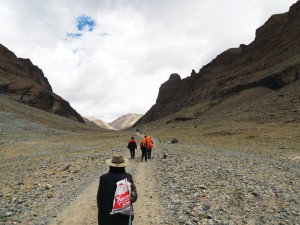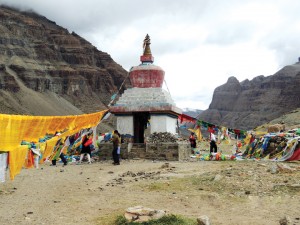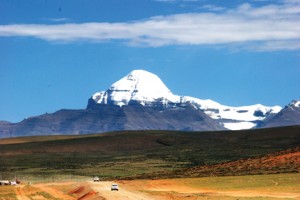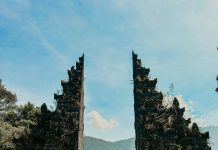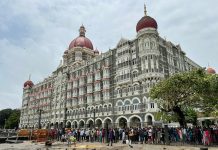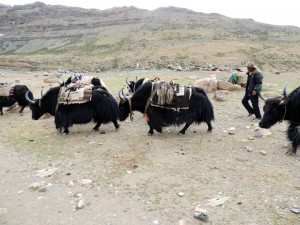 Long hailed as the ultimate spiritual destination, Mount Kailash and Lake Mansarovar are the Himalayas’ crown jewels, even for the non-religious folk. If you relish the challenge of journeying to places far removed from civilisation, this is for you, writes Aparna Sundaresan
Long hailed as the ultimate spiritual destination, Mount Kailash and Lake Mansarovar are the Himalayas’ crown jewels, even for the non-religious folk. If you relish the challenge of journeying to places far removed from civilisation, this is for you, writes Aparna Sundaresan
Mount Kailash – the snow-covered, insurmountable abode of Lord Shiva and his consort, Parvati, is one of the pillars of the world; or so it says in Hindu myths. In the real world, Kailash is not just an actual peak, but a nearly inaccessible one at that which lends even more mystique to its legendary status. Nestled in the Transhimalaya mountains in Tibet, Mount Kailash and its environs, which include the equally legendary Lake Mansarovar, have enjoyed an abiding sense of wonder, awe and intimidation. The clear and serene waters of Mansarovar are believed to be visited by the gods themselves everyday in the morning, from 3 am to 5 am.
For Hindus, Buddhists and Jains, this region will forever remain holy in their religious annals.
Buddhists believe Kailash is home to Buddha Chakrasamvara who represents supreme bliss. Jains, who know the peak as Meru Parvat or Sumeru, believe its neighbouring mountain, Ashtapad, is where the first Tirthankara, Rishabhadeva, attained liberation. It is thus no surprise that year after year thousands make the pilgrimage to Kailash and Mansarovar, keeping alive a tradition that is as ageless as the sites themselves.
If your idea of a holiday is not lazing around in a hotel or a beach, but being up on your feet and accomplishing something, Kailash-Mansarovar will not disappoint. For the adrenaline junkie, the intense outdoor lover, the achiever of the impossible, travelling to Kailash-Mansarovar and back is one heck of a holiday.
Know Where You’re Going
The Geographic Nitty-Gritty
Find them on the map: 30°N 81°E
Altitude: 6,638 m (Kailash), 4,590 m (Mansarovar) above sea level
Country of location: Tibet
Wow factors: No one has ever tried scaling Kailash before. And it’s not recommended either as it would hurt religious sentiments. As for Mansarovar, its waters appear to change colour every few seconds.
Climate Overview
Summer: May to October; day temperate as high as 22°C and night temperature as low as -10°C. Tibetan summers are dry and sunny, but expect rains in July and August.
Winter: November to April; average temperature below 0°C.
Are You Up For It?
Considering how far-flung and remote Kailash and Mansarovar are, it is time to stop viewing them as mere pilgrimage sites for the aged and religious. Visiting them is not for the faint-hearted. Even young, able-bodied people struggle to complete the journey. Here’s a checklist of how physically fit you must be to undertake the trip:
- No blood pressure issues • No altitude sickness • No breathing problems
- No asthma • No heart diseases • No epilepsy
As a precaution, do a complete health check-up and get a fitness certificate from your doctor before you travel.
Getting Started
Find a Tour Operator
Not even Indian Jones can make this trip by himself. The difficult terrain and sparse facilities en route demand travelling in groups under the guidance of experienced tour operators. Operators do all the grunt work, from getting you the necessary visa to organising transport throughout the trip. Some recommended operators:
- Yatra: http://yatra-india.com
- Kailash Mansarovar Yatra: http://www.kailashmansarovar.com/
- Kailash Mansarovar Yatra Pvt Ltd: http://www.kailashyatra.com/
Exercise everyday – walk or jog in the morning or evening, and if possible, trek too. Start getting fit as soon as you can.
Your all-essential checklist:
- After a certain point, you might wear as many as seven layers of clothing. Pack jackets, sweaters, gloves, caps with and without ear coverings, socks, scarves, shawls, track pants, thermals and any other woollen items you can think of.
- Regular clothes, nightwear and undergarments.
- Sturdy hiking boots/shoes. They must be light, waterproof, protect your ankles, be soft from the inside and have a firm grip underneath.
- Hooded raincoat.
- Bath and hand towels.
- Basic toiletries: toothpaste, tooth brush, soap, shampoo, comb, etc.
- Sunscreen with an SPF of 30 or more.
- Toilet paper rolls.
- Light backpack suitable for carrying when you trek.
- Hot water bottle.
- Binoculars.
- Torch and spare batteries.
- A plastic mug or vessel.
- Spectacles, if you wear them.
- Sun glasses.
- First aid kit and medicines: if you are under medication, carry what is prescribed to you. Check with your doctor first and then with your tour operator.
Anything else you want to carry is up to you, but remember to keep it light. Your tour operator will also guide you on packing.
On the Road
The Typical Route
Your trip will begin in Nepal from where you will follow this route more or less:
- Dhulikel: close to the Chinese border where you will clear immigration. You will cross over a bridge called Friendship Bridge.
- Nyalam: at 12,500 feet above sea level, this place will familiarise you with the thinning mountain air.
- Saga: 15,000 feet above sea level. From here on you will be required to drink at least 3 litres of water daily and pee every 45 minutes or so.
- Lake Mansarovar: You will see the marvellous Himalayan landscape en route. Circumambulate the lake, if not for religious reasons, for the opportunity to see its sheer natural grandeur. There is also a site to take a dip in the waters, but the weather must permit it. You will have a good view of Mount Kailash from the lake.
- Rakshasthal: steeped in mythological history, this nearby lake is believed to be where Ravana, the demon king of the Ramayana, performed a penance for Shiva. Its waters are considered to be poisonous and no bird flies over it.
- Ashtapad: the mountain peak holy to Jains where Rishabhadeva is believed to have attained liberation. You will see the south face of Kailash from here.
- Darchen: pit-stop. Buy necklaces and other jewellery made from semi-precious stones as souvenirs, but make sure you haggle to get a good bargain.
- Yama Dwara: literally, gate of Yama (god of death), last point a motor vehicle can go. Opt to continue the journey either on horseback or on foot.
- Diraphuk: see the north face of Kailash from here.
- Dolma Pass: 19,000-odd feet high. The terrain is rocky and inclined at nearly 90°. The Pass is believed to be Parvati’s domain. See Gauri Kund from here, the spring where Parvati is believed to take a bath. There is no oxygen up here, so don’t linger around.
- Zudulphuk: pit-stop on the way back to Darchen from where you will reverse your journey back into Nepal.
Some Words of Caution
- Friendship Bridge is over the fast-running Bhote Koshi river. Be careful with your passport as there have been instances of passports slipping through fingers and falling into the river.
- The air thins as you ascend, so you will start gasping for breath, especially at night when you lie down. Ask your operator for an oxygen cylinder. When you trek, don’t walk too fast. Sit down at intervals and catch your breath.
- You can fall sick at any point because of the low oxygen level. You might get toothaches, your face might swell in places and your nose might harden.
- Water is scarce. The last point you can take a shower is Nyalam. Be ready to give up shower gels and running water for seven or eight days thereafter.
- Be alert at Ashtapad. Jeeps and land cruisers have toppled off the path.






















